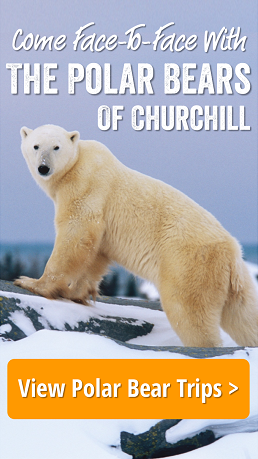by Steve Selden | Oct 23, 2010 | Tour News
A pretty calm day in the region as the winds subsided somewhat and many groups headed back home while another band of travelers came to town. Cool temperatures just below the freezing mark felt slightly colder with the breeze of the windchill.
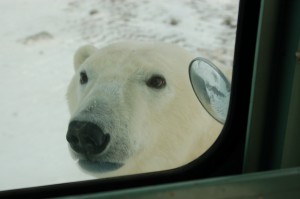
Images near the rear – view mirror may appear larger than they actually are! NHA photo.
Guide Karen was out on the tundra with her enthusiastic group. Amid the scattered thermokarsts, now almost completely covered with grease ice, the rover moved out between Gordon Point and first tower. A polar bear lying just off the trail on the edge of some willows took notice as they approached. The group stayed for a good while watching the reclined bruin as he periodically lifted his head and then reclined again. As they moved away from the bear and headed out they saw a large raft of surf scoters in the bay. A horned lark also flitted on the tundra in the drying foliage of long past berry plants. Near Ptarmigan Alley they spotted a bear off in the tidal flats sniffing and munching on some washed ashore animal part of some sort. The bear had some blood around the muzzle and paws. After his snack, he lumbered up to the rover and lingered about fifteen minutes under the rear observation deck. With increasing curiosity, the animal then reared up on hind legs and place his paws against the rover…his bulky frame coming only about a foot below the top railing. Travelers got great looks at the blood on his paws and face. Trick or treat!
On their trip back toward launch, the group spotted ptarmigan in and near the willows…two pure white and another few still with speckled white and gray feathers blending nicely with the ground. Another polar bear was spotted near a pond just after the turnoff to Halfway Point sitting up and sniffing the scents on the wind. Karen and her travelers watched for ten minutes or so and then headed to the launch and back into town.
That evening the group was presented with a lecture by Guide Bonnie Chartier on the first days of Churchill polar bear tourism. Bonnie and her husband at the time were the first pioneers of the then unheard of concept of ecotourism. Bonnie was standing in for Historian Bill Calnan who is also an agent for the Canadian shipping industry. Bill needed to be down at the port attending to a customs issue involving a ship.
Guide Eric and group had dinner out on the tundra lodge catered by Chef Sasha. The evening was a perfect way to enjoy the starkness and quiet out on the land in the evening. A couple of bears walked around in the shadows of the lodge and an arctic hare scampered here and there as the travelers enjoyed gourmet fare and good wine. On the way to the lodge, the group saw two polar bears lounging in the protection of some thick willows and after, on the way back to town, a huge male was caught in the headlights of the bus as he sauntered right down the middle of the road. We brake for bears…always.
by Steve Selden | Oct 22, 2010 | Tour News
High winds once again prevented the remaining ships out at five-fathom hole in the Hudson Bay from entering the Churchill River and docking at the port to load grain. Churchill often has prevailing northerly winds though these heavy prolonged gusts this early in the season are somewhat rare. It’s a great opportunity for all travelers to get a feel for harsh conditions experienced by the region throughout the long Winter. The polar bears of Churchill don’t seem to mind. The wind chill definitely bites at those without a furry coat.
Hudson Bay Helicopters still reports bears grouped together out around Cape Churchill in the East. Wapusk National Park has good numbers as well including a group of six or seven bears all gathered in a large patch of willows. Respite from the winds could explain these congregations. Some travelers were fortunate to view one of the largest bull moose seen in a long while. ..also in the park. Always a thrill to see these huge animals on the tundra from the air.
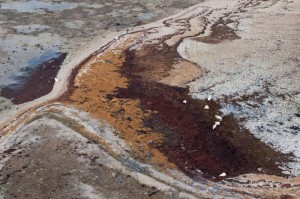
Trails in the Churchill Wildlife Management Area. Colby Brokvist Photo.
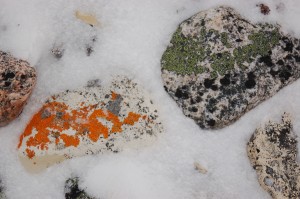
Colored lichen on the rocks in Churchill. Steve Selden photo.
Guide Amy and travelers had a solid day exploring the tundra. Near Halfway Point, early on, they had a smaller polar bear “crawling all over” their rover. Then after a long trek out to the Flats area, the group came upon two big males napping. Soon napping turned to sparring and the rover anchored down to enjoy the amazing show. Lunch was served as the two took breaks and then got back at it. Dessert was served and the two were still at each other toning muscles and honing their skills for protection. Just when the action started to culminate, another large male bear rose from resting near some willows and lumbered over to the two sparring partners. All looked bewildered at that point …the big male sat and the other two went their own ways. Maybe he was the referee informing the two that the fight was over.
The inland road back to launch provided ample views of colorful lichen species splattered over scattered rocks still straining to show their orange and green spores before the looming snows cover their light-source for the year. Looking back at the Hudson Bay the group took in an incredible scene with the old shipwrecked Ithaca in the distance and a polar bear silhouette in the foreground up on some rocks overlooking Bird Cove. A red fox was the final check on many folks’ list as they headed back…and sure enough one crossed right in front of the rover bringing tears to eyes to some folks on board. Great day in the CWMA!
Travelers with guide Karen experienced a bit more of a surreal, relaxing day viewing bears. Their first encounter was at Halfway Point as a male leaned in against a rocky outcrop, curious though indifferent with the rover, then positioned his hip back on the wall as if lounging on a plush couch. Stretching his long, beautiful neck into the steel gray sky to catch odors rising from the tumultuous waves of the bay, was enough to keep the group mesmerized for about 45 minutes. Then he finally moved from the spot and walked around the rover and sat down while coffee and hot chocolate were poured. On the Southerly side of the rover, a dark -phase gyrfalcon was once again stirring up annoyed snow buntings and riding the thermals gusting up over the rocky ledges. Two hours seemed like 10 minutes to all.
Later out toward the Flats, a bear that was up on another rover darted suddenly into the willows then came back out on the trail further ahead of where two other rovers were situated. As Karen and group passed them by and maneuvered closer to the four-year-old male, he would stand up on his haunches and give curious looks at the rover. This went on for a good 20 minutes until he finally disappeared off into the willows as fast as he appeared.
On the way back, along with Christmas Lake Esker, another polar bear approached and walked under the buggy sniffing the underside all the way and pausing to smell some human boots through the grate of the back deck. In the distance, two light and two darker caribous walked slowly together across the land. Binoculars captured their ghost-like steps in and out of the far off willows.
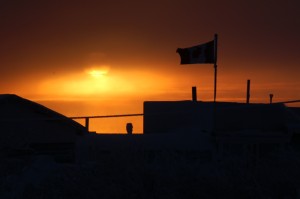
Sunset at the flats by the Churchill River. Steve Selden photo.
Guide Brent’s contingent had similar Christmas Lake Esker encounters viewing five caribous, one of those a calf, near the boreal forest that juts out into the tundra barren land. Prior to this sighting the group also had a three-year-old under their rover at Halfway point…curiously sniffing all over and then running off toward the rocks above the beach.
All groups, back in town, caught the zenith of the most incredible sunset of the season over the Churchill River. The pink, red and orange hues filtered down through the ice crystals in the sky and on the willows to create a brilliant glow that finally diffused to the North beyond Prince of Wales Fort and out past Button Bay.
by Steve Selden | Oct 21, 2010 | Tour News
Cold Northerly winds reaching 60kph continued throughout the day reaching top speed by late afternoon. Conditions made animal tracking a bit difficult. Periodic snow squalls continued to carpet the tundra and make all animals feel more at home…especially the Ptarmigan.
The final weeks of shipping grain from the Port of Churchill was certainly hampered by the high winds. The two ships previously at the port all but finished loading and at least one slip was now vacant. One of the vessels waiting out at five -fathom hole in the Hudson Bay was forced to turn back at 1:00 Am while trying to navigate into the mouth of the Churchill River and align with the channel markers positioned on the Western banks of the river. Heavy rollers with whitecaps made entering the mouth too risky as the thin channel is buffeted on either side by rocks and a shallow bottom. The vessel sailed back out into the bay to wait for a calmer approach.
On the land, in the CWMA, Guide Amy had one of her travelers dreams of a lifetime fulfilled as a small male polar bear decided to get up close and personal by standing up against the rover and sniffing at the windows. These animals have ultra keen sensory cells in their nasal passages and can smell seal or whale carcasses at a distance of 20 miles. When a rover with human-generated smells comes into their area the bears are prone to investigate…usually an amazing thrill for all aboard. Uh..keep the camera’s inside the windows please..it really ruins the natural bear pics when the bear has a Nikon hanging around his neck.
Guide Scott had similar experiences with his group out at Gordon point. For about 45 minutes a young male was up and down their rover and has been forever captured in the memories of all on the trip. The group also had a thrill last night when, at Halfway Point, they watched a peregrine falcon flush snow buntings from the willows attempting to have a late meal. Later in the day, the rover moved out to the flats area near ptarmigan alley and four other polar bears on and around the machine. The wind was picking up and after an amazing day on the tundra, the group was ready to “count its’ blessings” according to guide Scott and head back to launch. Behind them, the bay was kicking up the whitecaps while surfers in town were heading down to the beach. Cowabunga!
Guide Brent’s people were braving the wind chill while on the observation deck of their rover and spotted fresh polar bear and fox tracks in the early morning yet undisturbed snow covering. Brent also reported that virtually all ptarmigan now have complete coats of white…the snow coming none too soon. Near launch, early in their day, the group stopped near a stand of willows and viewed a young female nestled in the sheltered shrubs with her rear to the wind. Her youngish, round almost cartoonish face was captivating as she lifted her nose now and again to filter smells from the increasing gusts carrying a myriad of odors you and I would never recognize. After a full day, the group caught even better looks of the female on the way back into launch…she seemingly had not moved from her protective lair. If she had any thoughts of venturing out, the torrid gusts put an end to those.

A polar bear in the CWMA resting peacefully by the willows. Colby Brokvist photo
Some of the groups had an additional unique experience. Occasionally the military comes to Churchill to detonate remnant shells left over from the cold war era. “Cold war” in Churchill takes on a literal meaning and still continues today. However when Russia was causing rumblings around the globe back into the mid-fifties, some of the area now known as the CWMA was actually used for military preparation by a joint USA and Canadian forces. Every once in a long while, an old practice shell turns up out on the vast land and the specialists come in and detonate it. Over the years I have witnessed these procedures as some groups did. This one was in a fairly remote area but still heard by all. I guess that’s one reason the rovers stay on the trails. All in all the action on the tundra on this day was surely a blast…sorry.
by Steve Selden | Oct 20, 2010 | Tour News
The temperatures have fallen below the “Churchill” Maginot line. When the mercury finally dips below the 32F degree mark in October, there’s really no looking back until the ice finally breaks out of the Churchill River in Springtime. In the short term, for the next couple of months at least, the temperature drop usually translates to heightened polar bear activity within the Churchill region.

The Churchill Wildlife Management Area is covered with thermokarsts. Colby Brokvist photo.
Thousands of travelers come to view the infamous Churchill polar bears as they have become world renowned. However, we must keep in mind always that these bears descend on Churchill from Northern shoreline points where they abandoned the Springtime melting sea ice. As much as this two month period is prime-time to see polar bears in their natural habitat around Churchill, grave concern for their habitat in the North still demands our undivided attention. Over the past few decades, scientific evidence has shown decreasing sea ice linked to decreasing polar bear body mass and length. A longer ice free period has left polar bears on land for a longer time between spring and fall freeze-up of the Hudson Bay. With extended time off ice ,where they hunt seals for energy and fat reserves, survival rates of polar bears are decreasing. These basic harbingers point to increased concern overall for numbers of polar bears in the Western Hudson Bay population. A sample of this research can be found in an interview with polar bear biologist Andrew Derocher of the University of Alberta this past July on Yale’s Environment 360 website. Good reading.
Meanwhile, soon after guides Brent, Scott and Amy arrived in Churchill with excited travelers, the first polar bear “lift” of the season took place. Guides hurried their groups out to the polar bear compound to see a mom and two cubs of the year (coy’s) taken from the compound and readied for evacuation. The mom was placed in a net and the two cubs were seat-belted in the rear seats of the helicopter. The helicopter lifted off and hovered overhead momentarily then headed out. Kind of ironic for folks to come all this way to see polar bears and here’s Manitoba Conservation taking the bears away up North for release. Even so, all who were lucky enough to view the now-dusted had elated smiles and a unique story to tell.
Out on the snow dusted tundra of the CWMA, more stories were unfolding. Guide Elise had an “epic” day with her folks. In the morning, at Halfway Point, a juvenile male was sleeping in the rocks then rolling around periodically as well as walking along the rocky outcropping. Content with this sighting, the rover moved East along the coast and came upon an amazing sight. A seal carcass on the beach was being devoured by a polar bear. Within a short time, another larger male arrived and then one more came upon the scene. With three polar bears on the seal, stress naturally would arise. Soon two of the larger bears were grappling and sparring on two legs. Not unusual behavior for this time of year but with the bears muzzles and paws dipped in blood, the two bruins were soon splattering each others’ white fur with additional blood. The scene amazed all and some stellar photo’s were captured I’m sure.
Guides Leah and Rinnie at the tundra lodge had their folks viewing a bear rolling around and tumbling at the lodge. Some of the group, on a rover excursion between first tower and Ptarmigan Alley came upon a sow nursing two cubs…..some of the first reported nursing sightings of the season. All kinds of behavior starting to appear now as the season gets into gear.

An Arctic hare hides in the rocks along the Hudson Bay shore. Colby Brokvist photo.
While enjoying drinks and dinner on a night-rover excursion, guide Amy and her group kicked off their first night in Churchill with a beautiful evening on the tundra. A magnificent arctic hare was seen doing all sorts of yoga poses and stretching nestled in a rock outcropping on the coastal road. Relaxing night on the land.
by Steve Selden | Oct 19, 2010 | Tour News
Windy snow squalls and chilled North winds continued their onslaught on Churchill in the early morning. Winter continues to slip into the region most notably with the distinct appearance of ice forming on the edges of all the scattered ponds all over the surrounding tundra. A light dusting of snow covers the area… enough to ease everyone into the revelation that the long, frozen time between now and May or June is on the doorstep.
The Port of Churchill seems to always feel the pinch at this time of year as well. With the need to fill six more ships’ holds before the end of the season, dictated by ice forming in the Hudson Bay, crews are working round the clock to get the job done. It takes about four days to fill all the cargo space in an average size vessel and the port can accommodate two ships at the dock at once. The two at the port now will sail to Italy and Nicaragua in the next couple of days and two of the four ships waiting out at four-fathom hole in the bay will be ushered in via tugboat. The total number of ships for the year is 22… a good season.

A polar bear catches a scent in the breeze. Colby Brokvist Photo
On the land, bear numbers are increasing slightly as the snow and cold creeps in. Guide Sue and her folks covered extensive ground out in the CWMA and crossed paths with nine or ten polar bears. Way out East near ptarmigan Alley, two big male sub -adults lounged about occasionally acknowledging the rover and showing face for good photo’s. Later, after lunch at the tundra lodge, the group had another big male wandering around the rover and glancing up through the grate while sniffing at travelers’ boots.
Gyrfalcons and golden and bald eagles certainly are enjoying the lack of snow as evidenced by the white ptarmigan feathers scattered around the tundra. A banner year for ptarmigan numbers has translated into more raptor sightings, particularly gyrfalcons. The snow moving into the area should provide some respite for their prey. A report also was circulating that a researcher from Polar Bears International observed a golden eagle soar down and nab an arctic fox. It seems this year raptors are determined to take center stage on the food – chain platform. Every year a different species numbers seem more escalated….mother natures way of keeping a balance.

Polar bear alerted by movement near the willows. NHA photo.
Reports from Hudson Bay Helicopters are confirming at least 30 or so polar bears out at Cape Churchill and caribou sightings as well. Many travelers are getting great photographs with the barren tundra as background…a unique perspective for sure.
Guide Paul’s group was almost as far East as you can go in the CWMA and came across a polar bear in the willows quite close to the rover. The group stopped for a hot drink and snacks while the bear lifted his head every now and then for some quality pictures from excited guests. As they headed back to the tundra lodge, Paul picked out a bear through the spotting scope chewing on a willow branch. Seeing these different types of behavior is what it’s all about out on the tundra in their environment..lasting memories. At the lodge area, another male was stretching and moving around giving all aboard both the rover and the lodge a thrill.
Later in the evening Paul and travelers recounted the fantastic day on the tundra while listening to Evan Reeves on guitar in the seaport lounge… perfect ending to a day in the North.
by Steve Selden | Oct 18, 2010 | Tour News
With the precipitation gone, for the time being, the chilly air prevailed under gray skies. A thin layer of snow remains on the tundra..just enough to remind all visitors of the impending Winter.

Polar bear checking out the rover and travelers inside. Colby Brokvist photo.
Out in the CWMA, guide Paul Brown and his first group of travelers were near Halfway Point when they spotted a sleeping bear in the rocks. While watching the big male the group also got a great look at a tundra swan on a small secluded pond surrounded by willows. While viewing the swan through a spotting scope, Paul was able to assist some folks at taking photo’s through the scope to try to use the magnification as a telephoto type lens…this trick often provides excellent results in enlarging animals that cannot be approached at close range.
Later, on their way back to the lodge area, the group cruised by Gordon’s point and got fantastic looks at an arctic hare nestled down in the rocks. Since hares’ hair turns white on its’ internal clock rather than the external weather conditions, the white fur often gives away the animal when snow is not present. I can only imagine the animal feels the same way a human would feel if he or she walked naked in the middle of town.
Paul’s travelers were rewarded in the afternoon when they finally reached the lodge and their polar rover became the object of curiosity of another male polar bear. This gregarious animal walked around and under the back deck of the rover. At times he even stood on his hind legs and leaned onto the rover peering inside at thrilled travelers. Although most of the bears the group sighted during the day were fairly docile, this one was the thrill of a lifetime for most people on board.

A polar bear rests just beneath the grate of the Polar Rover’s back deck. NHA photo.
Meanwhile the day for guide Eric and travelers were shaping up nicely for wildlife viewing. The group viewed six bears throughout the day including one between ptarmigan alley and the tundra lodge. This bear also came under the buggy and sniffed a folk’s shoes through the grated back observation deck. Being that close to these massive animals can surely get the blood flowing…..thankfully inside the skin only.
Other high points of the day included spotting a large bull caribou just before the base of Gordon Point near the first tower. Eric sighted the animal in the distance while scanning the horizon for polar bears. A nice added bonus indeed!
As the energetic group headed back toward the launch, they noticed the shallow thermokarst (ponds) were forming rings of ice around their borders. On one of those ponds, a group of pintail ducks was preparing to head South to beat the weather. Nature’s version of a small suburban airport.
Guide Brad’s group also had a fulfilling day on the land. In addition to a good five or six bears, mostly lounging about, they witnessed one of those bruins, a sub-adult male, posing up on the rocks at Halfway Point with the clouds screaming across the sky just above the Hudson Bay beyond him. After, he walked around the rover and headed off into some willows nearby. Down on the coast nearby, they observed a raft of scoters as well. A tundra swan, possibly the same one Guide Eric and crew spotted was still floating around on a nearby thermakarst….content in its’ serenity.
Topping off a banner day..the group was presented with a regal silver fox in and out of willows…at first glance, it seemed to be a ptarmigan. Nice surprise.












